
Common Approaches to Filtration in Marine Aquariums
You have a few different options when it comes to providing proper filtration for your marine aquarium. The below are the common approaches to filtration in marine aquariums that I have used as well as some pros and cons.
There are three categories of filtration that you need to look at, biological, chemical, and mechanical filtration. Each has a slightly different purpose in your aquarium.
Biological filtration
The term biological filtration refers to the process of live bacteria converting organic waste in the form of ammonia and converting it into nitrites and further converting that into nitrates. This is also referred to as the nitrogen cycle. The two most common approaches to biological filtration are to use either live rock, or a filter with biological filter media (like you would find in a fresh water aquarium).
1) Live Rock: In the ocean, the rock formed from the calcified skeletons of corals provides a suitable media for the beneficial bacteria to grow on, which is what actually processes ammonia and nitrites and is a more natural way of providing biological filtration. There are many other benefits of using live rock in a marine aquarium that are discussed in the below link. This is always my preferred method for biological filtration and I always recommend it.
2) Filter(s) with biological filter media, or biological filter media in a sump can be very common to find in use in a marine aquarium. This is my least preferred method. While it certainly provides a lot of surface areas for bacteria to grow and can be very effective at converting ammonia and nitrites, the filter media will require additional maintenance in order to keep the media clean and to help prevent the media from adding higher than normal amounts of nitrates in the water. In addition, you will not be able to grow large enough colonies of the nitrate eating bacteria (discussed a little latter in this article). Many hobbyists do take this approach with no long term negative effects, just some extra weekly maintenance.
https://www.reefaquarium.com/2012/what-are-the-benefits-of-live-rock/
I have always had the best results using live rock for biological filtration. The times that I had tried using a canister filter with biological filter media, I had struggled to obtain close to the same results as the live rock would always provide me. However, I have very high personal standards when it comes to my water quality in my marine aquariums which is higher than most hobbyists.
Chemical filtration
Chemical filtration in a marine aquarium refers to using a filtering media which absorbs certain unwanted elements or certain pollutants out of the water. One of the most commonly used chemical filter media is the use of carbon to remove toxins from the water when/if some of your corals release toxins as a defense mechanisms into the water which can harm the rest of the marine life in your tank. Other popular chemical medias include: phosphate removers like Rowa Phos for removing phosphates, and carbon based media like Chemi-pure for removing silicates and other toxins just to name only two of them. You can use chemical filtration in a filter, a media reactor, or passively in a sump provided the flow is correct for the media being used. Just remember to check the manufacture’s recommendations for the proper use and follow those instructions.
I always prefer to have at least some chemical media in my set-ups as a precautionary measure in case any toxins are released into my aquarium. That is why I will use a carbon based media passively in the first compartment of my sump. In the past, I had also used phosphate removing media in a media reactor so I can control the flow to match the manufacture’s recommendations. Although I have not used any phosphate removers in a long time, I always have carbon based media in my marine set-ups.
Mechanical Filtration
There are a few different ways this is achieved. Among the more common ways is to use a filter pre sponge on a filter or skimmer intake, using filter socks on a drain line or in a sump, or using sponges between two sections of a sump. Some people do not even use any mechanical filter media in their marine aquariums at all. As I have sumps on my marine tanks, I choose to use filter socks for mechanical filtration. I prefer a 100 or 200 micron filter sock which seems to be fine enough to catch and filter out most partials from the water while not becoming clogged to fast. Many people will use 200 and 300 micron filter socks to filter out all partials from their water, but I have found the finer material will clog up too quickly. Mechanical filter media does require frequent cleaning in order to prevent nitrates from being produced and placed into the water. The exact frequency of the required cleaning will depend upon your set-up as this can vary greatly between different aquariums.
Nitrate and Phosphate Removal
This is the one area that hobbyist can spend the most effort on. Higher levels of nitrates and phosphates can lead to problems such as nuisance algae growth or even stressing your fish and/or corals if the levels get high enough. There are a few different ways you can do this. Live rock, Algae scrubbers, macro algae, Carbon dosing, water changes, Deep Sand Beds, and Refugiums.
1) Live rock will not only hold the bacteria that processes ammonia and nitrites, but it will also hold bacteria that also eats nitrates and converts nitrogen into a nitrogen gas which is released into the atmosphere. This is one of the more natural ways to reduce the nitrates produced by your set-up.
2) Algae scrubbers are designed to hold/grow algae allowing this algae growth to naturally remove nitrates and phosphates from the water. You are basically using I flow and high levels of lower spectrum lighting to grow algae. Although an algae scrubber can also provide some biological filtration, their primary benefit is the removal of nitrates and phosphates. This too is a very safe and proven way to remove both nitrates and phosphate from your set-up. You can find some more details about algae scrubbers in the following link. Some research suggests that one of the benefits of algae in your tank is that the algae can consume / filter out some unwanted trace elements out of the water (like you would expect from chemical filtration). The algae also provides a food source for most pods will also put some good trace elements back into the water.
https://www.reefaquarium.com/2013/some-algae-scrubber-basics/
3) Macro algae grown in your set-up can remove a lot of nitrates and phosphates from the water. Although a macro algae can also provide some biological filtration, their primary benefit is the removal of nitrates and phosphates. This is a very common approach for many hobbyist to use macro algae, like cheato ( the common name for Chaetomorpha algae), in a sump or refugium. Growing mangroves in your set-up is also said to work just as well as macro algae, but I have no firsthand experience with it. I have obtained really good results with a few different types of macro algae grown in a sump.
4) Carbon Dosing can also be very effective; however, it is not a good fit for most people who are new to the hobby. I had tried a few different approaches to carbon dosing and found it to have great results pretty fast as well. I now prefer to use more natural methods to removing nitrates and phosphates from my marine aquariums. The below link will give you a little more information about carbon dosing should you like to know more. There are some real risks to carbon dosing so make sure you do your homework first before trying it. I had stopped carbon dosing some time ago in favor of more natural methods that are a lot less risk to your set-up.
https://www.reefaquarium.com/2012/carbon-dosing-in-laymans-terms/
5) Deep Sand Beds I never have never actually tried this approach as I have never needed to explore other methods of removing nitrates / phosphates from the water. https://www.reefaquarium.com/2012/reef-filtration/
6) Refugiums can also be an effective means to remove nitrates and phosphates from your set-up. Although this really is not a unique form of nutrient removal, but it does allow you to include a combination of some of the above mentioned methods in a partially enclosed environment. The more commonly found approaches used include: deep sand beds, live rock, and macro algae. This can be set-up as a compartment in your sump, or as a separate tank/container plumbed into your set-up.
7) One of the simple and easiest ways to reduce nitrates and phosphates in aquarium still remains to complete a water change. An adequately maintained marine aquarium with a good weekly water change routine should have minimal nitrates and phosphates in the water.
As with most aspects to filtration, more is usually better. That is why I will always use a combination of a few different ways to remove nitrates and phosphates from my water. I will summarize what I use for filtration at the end of this article.
Protein Skimmers
They remove organic wastes / proteins (solid and otherwise ) from the water before these substances have a chance to break down and eventually result in nitrates. As a skimmer does this mechanically, it will not nicely fit in to one of the above mentioned categories. That is why I did not mention a skimmer under any of the above heading as it can be included in more than one category. This is only one of the many reasons that I will always have a skimmer on my marine aquariums. I like to have a skimmer that is rated for a higher water volume as compared to the set-up I am placing it on. The below links will help to explain a little more about how protein skimmers work
https://www.reefaquarium.com/2012/protein-skimmers/
When picking out a skimmer for your set-up, I would refer you to the below article which may help you select the correct skimmer for your aquarium
https://www.reefaquarium.com/2013/selecting-a-new-skimmer/
My Tank as an Example
I have always obtained great success by combining multiple forms of filtration in my marine aquariums. In my 180 gallon reef tank for example I am currently using the below approaches to filtration:
For chemical filtration I have chemi-pure (a type of carbon product) in the first compartment of my sump. I just run it passively there as there already is a lot of flow in that compartment which is very close to the flow suggested by the manufacture. It can be hard to see in the below picture, but you can still make out a part of one of the filter media bags beside the drain line on the left. For mechanical filtration, I have three filter socks, as seen between the first and second sump compartment. These are 100 micron socks which will filter out most of the fine partials from the water while not becoming clogged up too quickly. These filter socks get cleaned about every 4 days to a week.
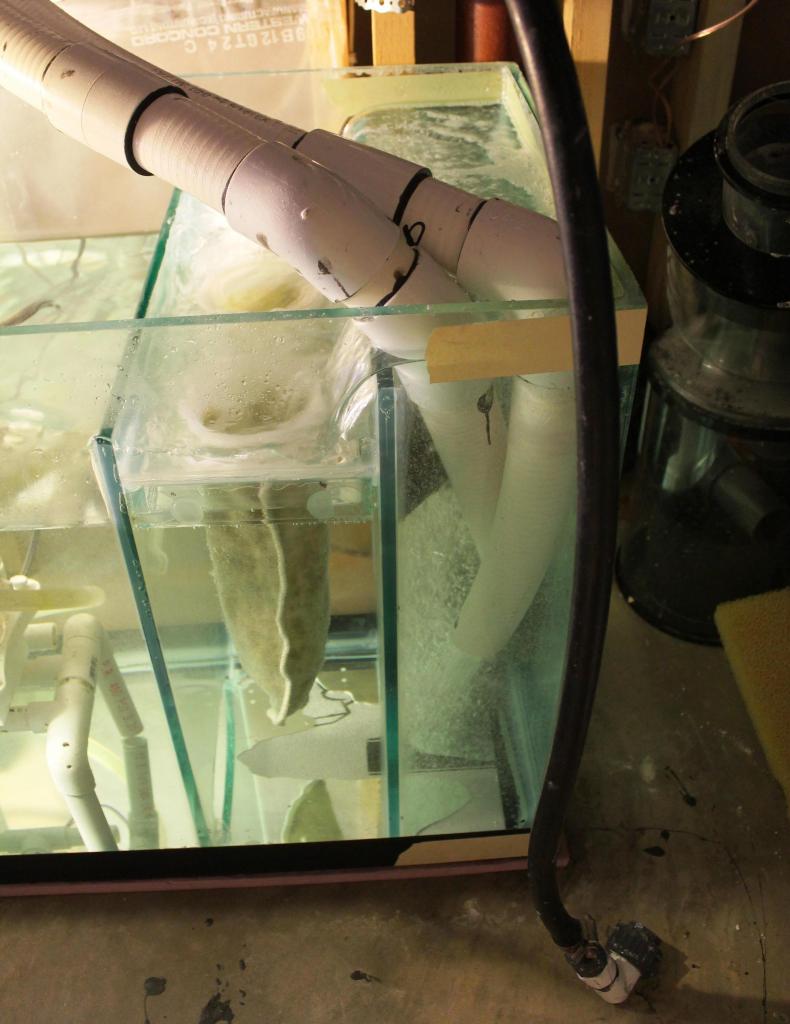
For mechanical and biological filtration I have a protein skimmer that is rated for around 200 gallons. Ideally any skimmer that I put on this tank should really be rated for around 300 gallons, but as I have other forms of filtration on this tank, this skimmer would be OK.
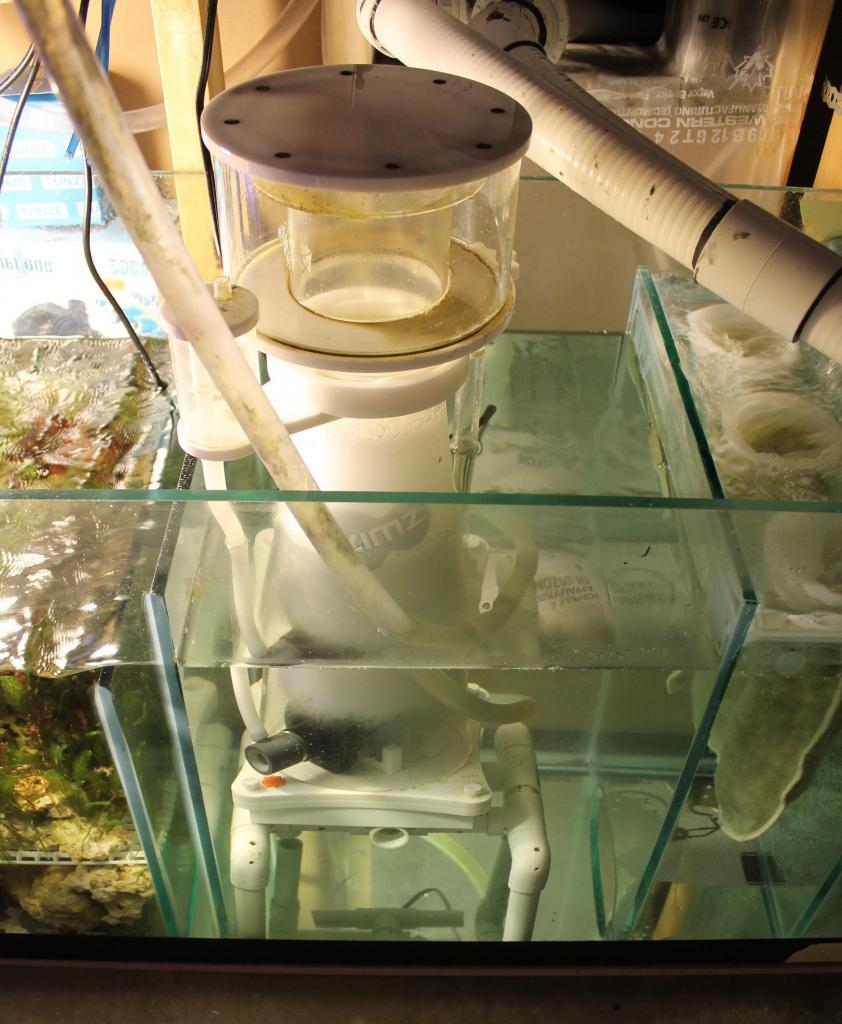
I also have a large compartment filled with macro algae (feather caulerpa. C. crassifolia to be exact). This will provide efficient removal of nitrates and phosphates from the water, and is a more natural way to accomplish this.
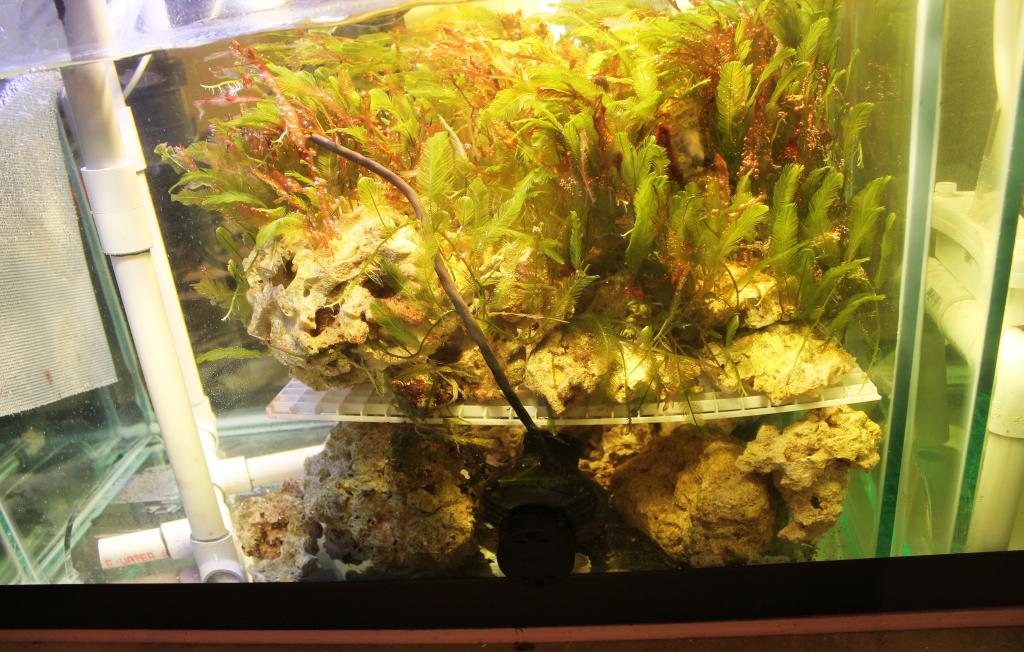
I also have an algae scrubber. The below pictures are of my most resent modifications to my algae scrubber in order to increase the algae growth. This is also is another natural means of removing nitrates and phosphates from the water. This biggest difference here is that it is a different type of algae as compare to macro algae pictured above. Using multiple types of algae provides a very efficient and more approach to natural nutrient removal.
You could argue that you should not have both macro algae and a properly sized algae scrubber on the same set-up as they will compete with each other for the same amount of nitrates and phosphates. I have noticed a drastic reduction in the growth of my macro algae once the scrubber started growing alga and removing nutrients out of the water. My reasoning behind this approach is due to my plans to increase the bioload in my tank which would most likely become beyond the capacity of my scrubber.
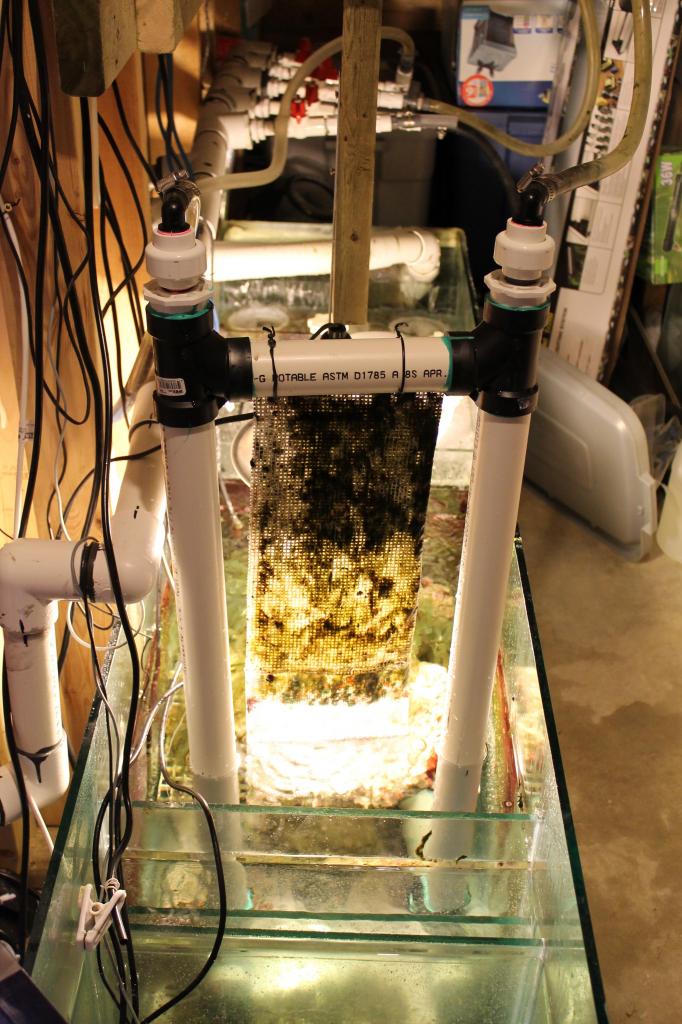
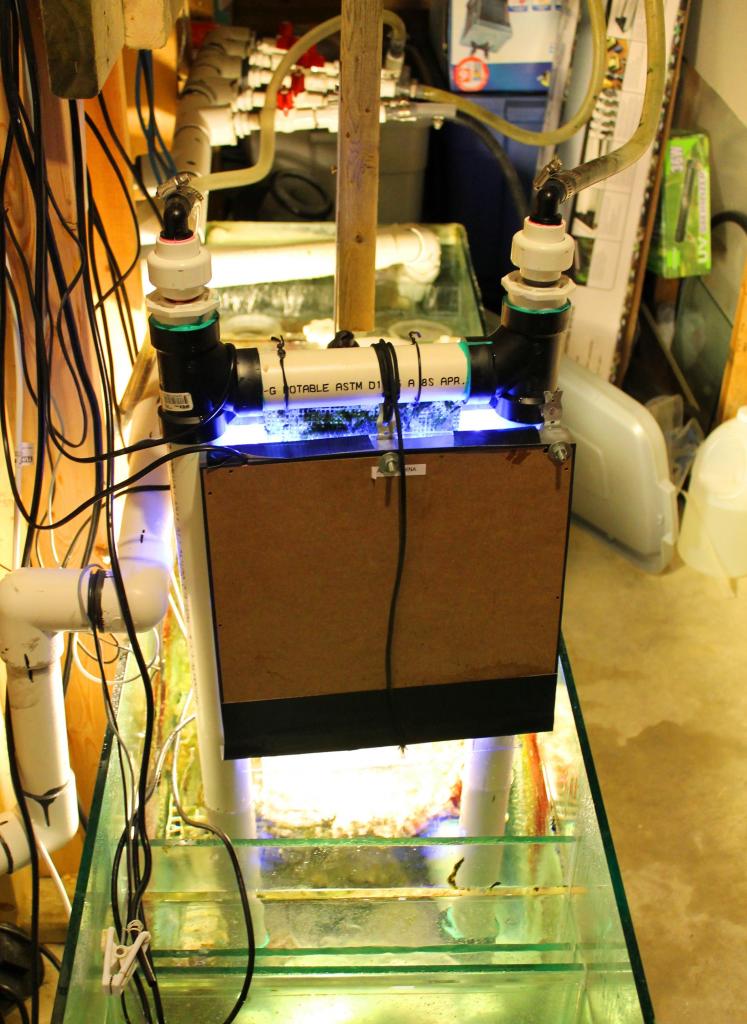
If you would like to learn more about algae scrubbers, please use the blow link to find more information.
https://www.reefaquarium.com/2013/some-algae-scrubber-basics/
And, of course, I have about 250 to 300 lbs of live rock in the main tank and sump. This provides the set-up with all of the biological filtration that I would need. The live rock also provides a means of nitrate removal. The below pic was taken before I started adding a lot of SPS corals to this set-up. Who would have guessed filtration could look so good.

Through using these multiple approaches to filtration in my marine tank, my water parameters for: ammonia, nitrites, nitrates, and phosphates all remain undetectable by my test kits.
For some additional information
Hi Cliff.
I found you your website on reef tank filtration very good to understand where everything fits in place. The only part that I do have a problem on is nitrates, and think I have found the problem now on my filtration, where the extra nitrates are being added in, so thanks for taking the time to put your setup out there, for beginners like me.
Regards,
Garrick
Thanks Garrick. I’m glad you found this helpful
Hi Cliff,
I just bought a 65gal reef tank from a friend a month ago. The tank has plenty of rocks but some purple algae start to grow recently. What do I need to do to get rid of these algae? I start to lower the light from 12+hrs a day to 8-9hrs.
The purple algae is flat and not “leafy”, then you are seeing is called Coraline Algae. It is a really good sign of a set-up that is starting to mature. This is not a type of nasty algae that you want to get rid of. You want to keep coraline algae
Google some pics to confirm if that is what you have growing.